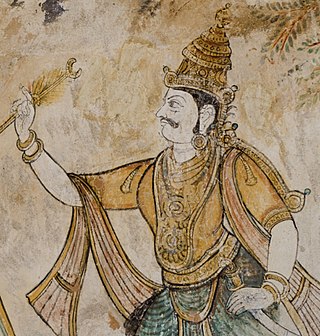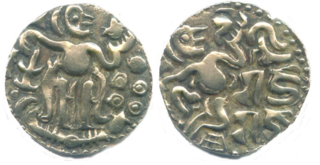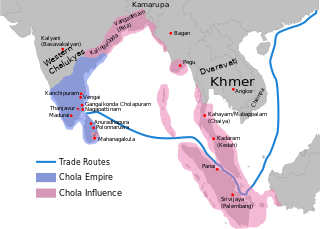Tamils maintained a good relationship with the Chinese, with evidence of trade relations going back to 2nd century BC. [ citation needed ]
Contents

Tamils maintained a good relationship with the Chinese, with evidence of trade relations going back to 2nd century BC. [ citation needed ]

[1] The relationship between the Chinese and the Tamils is 3000 years old. [ citation needed ] Trade and Cultural exchanges flourished during the reign of the Pallavas. In the 8th century, the Tang dynasty, forged a military alliance with Narasimhavarman II and made him the General of the South China to safeguard from the expanding Tibetan Empire. [2] [ unreliable source? ]
Kanchipuram was an ancient center of Buddhism and learning visited by the Chinese traveller Xuanzang, who recorded that there were Hindu temples and Buddhist Pagodas in the city and the city was the center of learning for Tamil, Prakrit, Pali, Sanskrit, Engineering, Medicine and Philosophy in all of South and Southeast Asia. Buddhist Monks Buddhabadra and Bodhidharma travelled from Tamizhagam to China and established the Shaolin Monastery to spread Zen Buddhism. This eventually led to the transfer of knowledge of Siddha and Kalaripayattu, thereby developing into Chinese martial arts form of Shaolin Kung Fu.
The relationship between the Chinese and the Cholas dates back to second century BC. According to ancient Chinese scholar Ban Gu, China sent an ambassador to the court of the Cholas. [3] In his work the Book of Han (Ch'ien Han Shu), Ban Gu mentions seeing at the city of 'kuvangtche' many objects that were unknown to China at that time. Berend, an acoustics expert, annotates that the city named by Ban Gu is analogous with the ancient Chola city 'kanchi' (the present day city of Kancheepuram in Tamil nadu, India). This suggests that Kanchi may have been an important hub for trade between the Chola kingdom and China. [4]
The medieval and later Cholas too maintained a healthy relationship with the Chinese. During the reigns of Rajendra Chola I (r. c. 1014 AD – c. 1044 AD) and Kulothunga Chola I (r. 1070–1122 CE), commercial and political diplomats were sent to China. Cholas sent ambassadors to the Court of China and Merchants from Tamizhagam traded in Chinese goods. The Kaiyuan Temple is a shiva temple built by the Tamil traders in China. [5] [6]
Zheng He, a Chinese mariner, explorer, diplomat and fleet admiral of the Ming Dynasty visited Tamil Nadu and Eelam and left the Galle Trilingual Inscription, a stone tablet with an inscription in three languages, Chinese, Tamil and Persian, in Galle, Sri Lanka. The stone tablet, dated 15 February 1409, was installed by the Chinese admiral in Galle during his grand voyages. The text concerns offerings made by him and others to the Sri Pada Mountain in Sri Lanka. The Chinese inscription mentions offerings to Buddha, the Persian in Arabic script to Allah and the Tamil inscription mentions offering to Tenavarai Nayanar (Hindu god Vishnu).
Arrays of ancient Chinese coins have been found at places considered to be the homeland of the Cholas (i.e. the present Thanjavur, Tiruvarur, Nagapattinam and Pudukkottai districts of Tamil Nadu, India), further confirming the existence of trade and commercial relationship between the Cholas and the Chinese. [7]
| Place | Number of coins | Other details |
|---|---|---|
| Olayakkunnam | 323 | These coins belong to 142-126 BC. This village is situated in Pattukkottai taluk in Pudukkottai district of Tamil Nadu, India |
| Thaalikkottai | 1822 | This village is situated in Mannargudi taluk in Tiruvarur district of Tamil Nadu, India |

The Tamil people, also known as Tamilar, or simply Tamils, are a Dravidian ethno-linguistic group who trace their ancestry mainly to India’s southern state of Tamil Nadu, union territory of Puducherry and to Sri Lanka. Tamils who speak the Tamil Language and are born in Tamil clans are considered Tamilians. Tamils constitute 5.9% of the population in India, 15% in Sri Lanka, 7% in Malaysia, 6% in Mauritius, and 5% in Singapore.

The Pandyan dynasty, also referred to as the Pandyas of Madurai, was an ancient Tamil dynasty of South India, and among the three great kingdoms of Tamilakam, the other two being the Cholas and the Cheras. Existing since at least the 4th to 3rd centuries BCE, the dynasty passed through two periods of imperial dominance, the 6th to 10th centuries CE, and under the 'Later Pandyas'. The Pandyas ruled extensive territories, at times including regions of present-day South India and northern Sri Lanka through vassal states subject to Madurai.

Rajaraja I, often described as Rajaraja the Great, or Mummudi Chola as was a Chola emperor who reigned from 985 CE to 1014 CE. He was the most powerful Tamil king in South India during his reign and is remembered for reinstating the Chola influence and ensuring its supremacy across the Indian Ocean.

Kulottunga I also spelt Kulothunga, was a Chola Emperor who reigned from 1070 CE to 1122 CE succeeding his cousin Athirajendra Chola. He also served as the Eastern Chalukya king from 1061 CE to 1118 CE, succeeding his father Rajaraja Narendra. His birth name was Rajendra. He is related to the Chola dynasty through his mother's side and the Eastern Chalukyas through his father's side. His mother, Ammangaidevi, was a Chola princess and the daughter of emperor Rajendra I. His father was king Rajaraja Narendra of the Eastern Chalukya dynasty who was the nephew of Rajendra I and maternal grandson of Rajaraja I. According to historian Sailendra Nath Sen, his accession marked the beginning of a new era and ushered in a period of internal peace and benevolent administration.
Rajendra Chola I , often referred to as Rajendra the Great, and also known as Gangaikonda Chola, and Kadaram Kondan was a Chola Emperor who reigned between 1014 and 1044 CE. He is considered the most significant ruler in early eleventh century South Asia for his role in patronising the arts, encouraging trade and expanding the Chola Empire to is greatest extent.

Kanchipuram also known as Conjeevaram, is a city in the Indian state of Tamil Nadu in the Tondaimandalam region, 72 km (45 mi) from Chennai – the capital of Tamil Nadu. Known as the City of Thousand Temples, Kanchipuram is known for its temple architectures, 1000-pillared halls, huge temple towers and silk saris. Kanchipuram serves as one of the most important tourist destinations in India. Kanchipuram has become a centre of attraction to the foreign tourists as well. The city covers an area of 36.14 km2 (13.95 sq mi) and an estimated population of more than 300,000 in 2021. It is the administrative headquarters of Kanchipuram District. Kanchipuram is well-connected by road and rail.

Rajadhiraja I was a Chola emperor, the most skilled military commander among the Chola rulers and the successor of his father, Rajendra I. He was the only Chola emperor who was killed while leading his army in war, and although he had a short reign, he helped his father conquer several territories as well as to maintain the Chola authority over most of Sri Lanka, Eastern Chalukya and Kalinga, among others. He also established imperial relations with overseas allies despite a series of revolts in the territory.

The Chola dynasty was a Tamil thalassocratic empire of southern India and one of the longest-ruling dynasties in world history. The earliest datable references to the Chola are from inscriptions dated to the 3rd century BCE during the reign of Ashoka of the Maurya Empire. As one of the Three Crowned Kings of Tamilakam, along with the Chera and Pandya, the dynasty continued to govern over varying territories until the 13th century CE. The Chola Empire was at its peak and achieved imperialism under the Medieval Cholas in the mid-9th century CE.

Tamiḻakam refers to the geographical region inhabited by the ancient Tamil people, covering the southernmost region of the Indian subcontinent. Tamilakam covered today's Tamil Nadu, Kerala, Puducherry, Lakshadweep and southern parts of Andhra Pradesh and Karnataka. Traditional accounts and the Tolkāppiyam referred to these territories as a single cultural area, where Tamil was the natural language and permeated the culture of all its inhabitants. The ancient Tamil country was divided into kingdoms. The best known among them were the Cheras, Cholas, Pandyans and Pallavas. During the Sangam period, Tamil culture began to spread outside Tamilakam. Ancient Tamil settlements were also established in Sri Lanka and the Maldives (Giravarus).
Ainnurruvar is a medieval merchant guild originating in the Tamil Nadu region of India between the eighth and 13th centuries. In this period, organised merchant guilds exerted considerable power and influence. Ainnurruvar was one of the most prominent of these guilds. During the Chola Empire they were regarded as the elite amongst the South Indian merchant organizations.

The Ashtabujakaram or Ashtabuja Perumal Temple located in Kanchipuram in the South Indian state of Tamil Nadu, is dedicated to the Hindu god Vishnu. Constructed in the Dravidian style of architecture, the temple is glorified in the Nalayira Divya Prabandham, the early medieval Tamil canon of the Alvar saints from the 6th–9th centuries CE. It is one of the 108 Divya Desams dedicated to Vishnu, who is worshipped as Ashta Bhuja Perumal and his consort Lakshmi as Alamelumangai.

Nainativu, is a small but notable island off the coast of Jaffna Peninsula in the Northern Province, Sri Lanka. The name of the island alludes to the folklore inhabitants, the Naga people. It is home to the Hindu shrine of Nagapooshani Amman Temple; one of the prominent 64 Shakti Peethas, and the Buddhist shrine Nagadeepa Purana Viharaya.

Karunakara Tondaiman was a general of Chola Emperor Kulottunga I. He is renowned for leading the Chola invasion of Kalinga during the reign of Kulottunga I and is the hero of Jayamkondar's poem Kalinkkattuparani In the Parani poem he is referred to as the lord of Vandai. while in the Draksharamam inscription of Kulottunga I, he is called as Vanduvaraja and Pallavaraja. He also served as a minister under Kulothunga Chola's son and successor, Vikrama Chola.

Buddhism amongst the Tamils was historically found in the Tamilakam region of India and Northern Sri Lanka.
Perumbanappadi was the original home of the historic Bana Chieftains of the early Pallava period. It extended from the South Pennar to the Tirupati (Thirumala) hills. Perumbanappadi was made up of sub-divisions such as the Thiruvenkata-Kottam, and many Nadus such as Tuy-nadu, Puli-nadu, Vada Pulinadu, and Silai-nadu within it. During the Chola period, Perumbanappadi was a major division of the Jayakonda Chola Mandalam. and also represented the north-western portions of Thondai-Mandalam.

The Three Crowned rulers, or the Three Glorified by Heaven, or World of the Three or The Tamil Kings, primarily known as Muvendar, refers to the triumvirate of Chera, Chola and Pandya who dominated the politics of the ancient Tamil country, Tamilakam, from their three Nadu (countries) of Chola Nadu, Pandya Nadu and Chera Nadu in southern India. They signalled a time of integration and political identity for the Tamil people. They frequently waged war against one another under a period of instability and between each other, held control over Greater Tamilakam from 6th century BCE to the 13th century.

Jainism has an extensive history in the Indian state of Tamil Nadu, although practiced by a minority of Tamils in contemporary times. According to the 2011 India Census, Jains represent 0.12% of the total population of Tamil Nadu, and are of the Digambara sect. Tamil Jains are primarily concentrated in northern Tamil Nadu, in the districts of Madurai, Viluppuram, Kanchipuram, Vellore, Tiruvannamalai, Cuddalore and Thanjavur.

Southeast Asia was in the Indian sphere of cultural influence from 290 BCE to the 15th century CE, when Hindu-Buddhist influences were incorporated into local political systems. Kingdoms in the southeast coast of the Indian Subcontinent had established trade, cultural and political relations with Southeast Asian kingdoms in Burma, Bhutan, Sri Lanka ,Thailand, Indonesia, Malay Peninsula, Philippines, Cambodia and Champa. This led to the Indianisation and Sanskritisation of Southeast Asia within the Indosphere, Southeast Asian polities were the Indianised Hindu-Buddhist Mandala.

The Cholas, the Tamil kings of the Chola dynasty who had ruled most parts of South India, maintained a strong relationship with the Chinese.

Tamil dynasties are the kingdoms who ruled over present day Tamil Nadu, Sri Lanka, Andhra Pradesh, Karnataka, Kerala and Odisha. These include the Pallavas, the Pandyas, the Cholas and the Cheras.